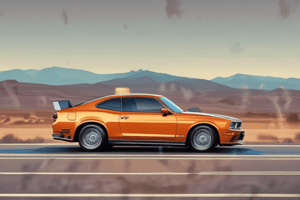Podcast
Questions and Answers
What is a potential hazard when releasing latches on trunk rear hatches or engine hoods?
What is a potential hazard when releasing latches on trunk rear hatches or engine hoods?
- Hinge failure may result in sudden closure.
- Freezing temperatures may cause the latch to stick.
- Corrosion may weaken the latch mechanism.
- Excessive pressure may cause explosive force. (correct)
Why should one avoid directing a hose stream into a fuel tank?
Why should one avoid directing a hose stream into a fuel tank?
- It may create a vacuum that implodes the tank.
- The hose stream may freeze the fuel, leading to a blockage.
- It can dilute the fuel, making it less effective in fires.
- It can cause pressurization and result in burning fuel discharge. (correct)
What should be done to ensure personal safety when dealing with heat-exposed gas cylinders?
What should be done to ensure personal safety when dealing with heat-exposed gas cylinders?
- Regularly inspect the cylinders for leaks to ensure safety.
- Allow sufficient clearance and maintain a safe distance. (correct)
- Quickly open hatches to vent gas before it can expand.
- Stand close while releasing latches to minimize exposure.
What occurs in well-sealed interiors of modern vehicles during a fire?
What occurs in well-sealed interiors of modern vehicles during a fire?
What could be a consequence of fire exposure to vehicle tires or split rims?
What could be a consequence of fire exposure to vehicle tires or split rims?
When managing fires in trunk/cargo areas, what should firefighters anticipate?
When managing fires in trunk/cargo areas, what should firefighters anticipate?
What precaution must be taken regarding air suspension systems in larger vehicles during a fire?
What precaution must be taken regarding air suspension systems in larger vehicles during a fire?
Which safety measure is critical before entering a vehicle on fire?
Which safety measure is critical before entering a vehicle on fire?
What is a critical action to take before entering a vehicle that is on fire?
What is a critical action to take before entering a vehicle that is on fire?
How should firefighters approach a vehicle that may have exploding tires or rims?
How should firefighters approach a vehicle that may have exploding tires or rims?
What hazard should be anticipated when dealing with batteries in a vehicle fire?
What hazard should be anticipated when dealing with batteries in a vehicle fire?
What potential issue arises when gas cylinders used in hold-open devices are exposed to high heat?
What potential issue arises when gas cylinders used in hold-open devices are exposed to high heat?
What could happen if the gas cap of a pressurized fuel tank is removed during a fire?
What could happen if the gas cap of a pressurized fuel tank is removed during a fire?
How should firefighters handle a well-sealed modern vehicle during a fire?
How should firefighters handle a well-sealed modern vehicle during a fire?
What effect can excessive heat have on vehicle air suspension systems?
What effect can excessive heat have on vehicle air suspension systems?
What is a common concern involving the contents of a trunk during a fire?
What is a common concern involving the contents of a trunk during a fire?
Flashcards are hidden until you start studying
Study Notes
General Hazards and Safety Considerations
- Energy absorbing bumpers use gas and fluid-filled cylinders that can develop high pressure when heated, leading to sudden release and potential injuries, with bumpers capable of traveling up to 25 feet.
- Batteries pose risks of explosion, flammability, toxicity, and electrical shock; avoid contact with battery components.
- Hold-open devices on trunk hatches and engine hoods may incorporate springs or gas cylinders, which can fail or rupture if heated, resulting in explosive openings.
- Releasing latches on hot compartments requires sufficient clearance to prevent injury from sudden openings.
- Approach fires in the trunk or cargo area with caution, as contents may include toxic and flammable materials; prepare for hazardous outcomes.
- Fuel tanks, made of sheet metal or plastic, can rupture or burn-through, potentially causing rapid flash fires; do not remove gas caps from pressurized tanks.
- Avoid directing water streams into pressurized tanks to prevent burning fuel from spewing out of the fill opening.
- Well-sealed vehicle interiors can cause vent-limited fires that may intensify when fresh air is introduced; exercise caution when entering or ventilating the vehicle.
- Always have a charged handline ready before entering a vehicle, and ensure at least one team member is equipped with forcible entry tools for safe access.
- Tires or split rims exposed to fire may explode, posing risks of sudden drops in vehicle stability; approach the vehicle from the front or rear for added protection against flying debris.
- Air suspension systems in larger vehicles, such as buses, can fail under heat, resulting in the vehicle dropping unexpectedly.
- When rescuing trapped individuals, first apply water to protect patients; if no rescue is needed, cool the area around fuel tanks, especially if they contain LPG or CNG, to prevent fires.
General Hazards and Safety Considerations
- Energy absorbing bumpers use gas and fluid-filled cylinders that can develop high pressure when heated, leading to sudden release and potential injuries, with bumpers capable of traveling up to 25 feet.
- Batteries pose risks of explosion, flammability, toxicity, and electrical shock; avoid contact with battery components.
- Hold-open devices on trunk hatches and engine hoods may incorporate springs or gas cylinders, which can fail or rupture if heated, resulting in explosive openings.
- Releasing latches on hot compartments requires sufficient clearance to prevent injury from sudden openings.
- Approach fires in the trunk or cargo area with caution, as contents may include toxic and flammable materials; prepare for hazardous outcomes.
- Fuel tanks, made of sheet metal or plastic, can rupture or burn-through, potentially causing rapid flash fires; do not remove gas caps from pressurized tanks.
- Avoid directing water streams into pressurized tanks to prevent burning fuel from spewing out of the fill opening.
- Well-sealed vehicle interiors can cause vent-limited fires that may intensify when fresh air is introduced; exercise caution when entering or ventilating the vehicle.
- Always have a charged handline ready before entering a vehicle, and ensure at least one team member is equipped with forcible entry tools for safe access.
- Tires or split rims exposed to fire may explode, posing risks of sudden drops in vehicle stability; approach the vehicle from the front or rear for added protection against flying debris.
- Air suspension systems in larger vehicles, such as buses, can fail under heat, resulting in the vehicle dropping unexpectedly.
- When rescuing trapped individuals, first apply water to protect patients; if no rescue is needed, cool the area around fuel tanks, especially if they contain LPG or CNG, to prevent fires.
Studying That Suits You
Use AI to generate personalized quizzes and flashcards to suit your learning preferences.




